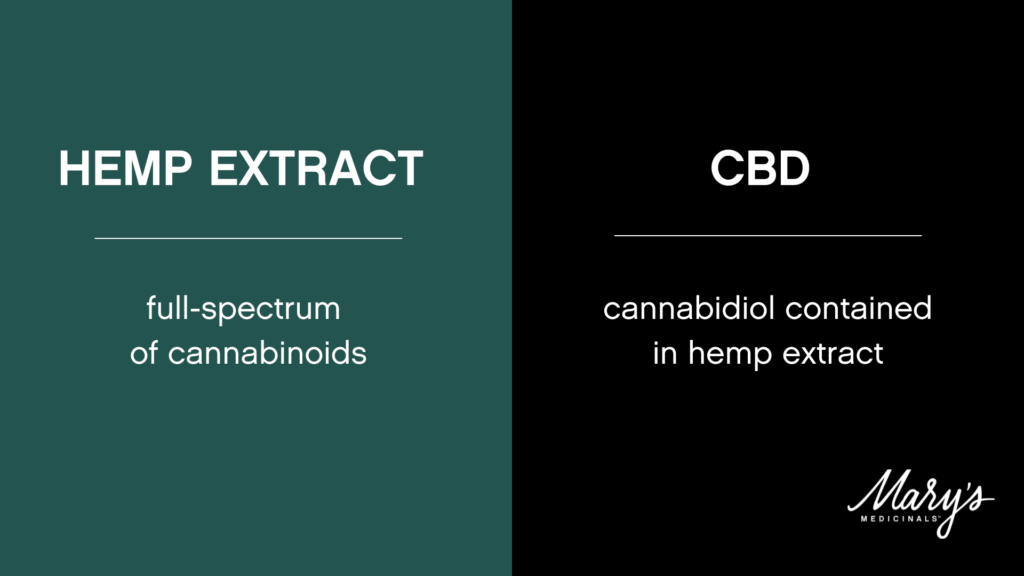We sat down with our Chief Scientist, Jay Denniston, to get answers to some of the most-asked questions we receive about CBD. While the average person knows more about CBD than ever before, there are still many key questions people have about this popular cannabinoid.


Jay Denniston joined the cannabis industry in 2010 to promote scientific principles and techniques to the industry. He brings his expertise in biochemistry, analytical chemistry, forensic toxicology, food science, quality control, and product development to Mary’s Medicinals as Chief Scientist.
What is the difference between CBD and Hemp Extract?
While many people conflate the two terms, they are distinctly different. Hemp extract typically refers to the biomass extractive containing a full-spectrum of cannabinoids, aromatics and terpenes, pigments, flavonoids, and many other phytochemicals. CBD refers specifically to only the cannabidiol contained within the hemp extract. CBD can be isolated from hemp extract using refinement techniques such as chromatography and distillation.


Although CBD is the most popular, other phytochemicals can be isolated and purified from hemp extract, such as terpenes, flavonoids, and fatty acids. The additional phytochemicals in hemp extract and in marijuana work in harmony with CBD to promote a collective efficacy.
Regardless of source, the purified CBD from either hemp or cannabis is the same molecular structure and presents the same mechanism of action.
How does CBD differ from THC?
These two most popular cannabinoids have some similarities, but very different mechanisms of action. Both CBD and THC have the same molecular formula but have a different arrangement of those atoms.
They act on the endocannabinoid system (ECS) at the cellular level throughout the nervous systems in all vertebrates. THC can bind to either CB1 receptors, found in the central nervous system, or to CB2 receptors, found mainly in the peripheral nervous system. These receptor sites are responsible for the release of neurotransmitters that aid in complex cellular signaling. CBD has a weak affinity for both CB1 and CB2 receptors and can act to block THC binding. Instead, it’s widely believed that CBD can act in the interstitial space between cells to prevent the breakdown of beneficial endocannabinoids. Since the location of the CB1 receptors are in the brain, THC induces psychoactivity, while CBD does not.

Another big difference in the two cannabinoids is the scope of legality and availability. THC (the naturally-occurring compound that is found in high levels in the cannabis plant) was federally prohibited in 1970 with the passage of the Controlled Substances Act and is available only in state-approved and regulated dispensaries. CBD is not prohibited and is publicly available through typical brick and mortar storefronts and online websites, such as MarysNutritionals.com. CBD is a naturally occurring compound that can be found in high levels in both hemp and marijuana.
What are the benefits of CBD?
The reported benefits of CBD include pain relief, nausea reduction, migraine relief, anxiety reduction, anti-epileptic, anti-seizure, anti-inflammatory, relaxation and sleep promotion, antioxidation, and radical scavenger (anti-cancer and neuroprotective). However, due to the nascency of the industry and lack of extensive research on CBD, evidence is limited and often anecdotal. More research is needed to prove out the potential benefits of CBD.
Is all CBD created equal?
At the molecular level, all cannabidiol is equal. However, since most CBD is accompanied with additional phytochemicals which modulate and affect homeostasis, efficacy and results vary widely depending on source and refinement techniques.
People should do their research before selecting a CBD product. At Mary’s we only source organic, locally grown CBD for our products and we provide Certificates of Analysis for both raw material and final products. Our goal is to be as diligent as possible in providing quality CBD products.
What should someone know to determine if CBD is right for them?
Since CBD is widely tolerated and similar in function to our existing endocannabinoids, there is little risk to trying CBD. More than the CBD itself, someone should consider the delivery method, dosage, and ingredient list before determining if a specific product containing CBD is right for them.
Many pet parents also use CBD for dogs for a range of wellness benefits.
What are the most popular delivery methods of CBD and how do they differ?
The most common form of consumption is via inhalation. Inhaled products include all forms of extract and flower and are intended to be heated to the point of combustion or vaporization to be inhaled into the lungs for rapid absorption and quick onset time. However, due to high temperatures of combustion and reduced bioavailability, many consumers seek out other delivery formats.
Edibles are foods that are infused with cannabinoids. CBD is absorbed into the bloodstream during the process of chewing and swallowing, in addition to being metabolized in the liver during the digestive process. This method generally has the lowest bioavailability since the cannabinoids can be lost during metabolization but is also the most approachable and delicious. Common forms of edibles include confections like gummies and chocolates, capsules, tablets, and beverages.
Sublinguals, such as The Remedy CBD, deliver CBD for absorption through the oral mucosal tissues of the mouth. Common formats include edible oil tinctures (administered through a dropper) and sprays.
CBD can also be delivered onto the skin in a topical format and through the skin in a transdermal format where it reaches deeper into the skin’s layers and can be absorbed into the bloodstream. Since the skin is the largest organ in the body and contains cannabinoid receptors of the endocannabinoid system, topical application of CBD can be very beneficial. The level of absorption can be surface (salve), subcutaneous (lotion), or intravenous (transdermal) depending on the purpose and desired result. Topicals and transdermals include creams, salves, lotions, and bath soak.


How much CBD should one use?
There are no FDA recommended amounts, so dosages range from as low as 2.5mg/kg body weight twice daily to over 500mg/day. Many edible products have standardized 5mg and 10mg as a typical single dosage amount, but studies have shown that high doses of up to 1,500mg can be well tolerated.
Generally speaking, one should start with as small a dosage as possible to find the minimal effective amount for the individual – which varies person to person depending on metabolism, body weight, what you’ve eaten that day and more. Remember that more is not always better and that it’s possible to produce synergies with other phytochemicals for an Ensemble Effect (also known as the entourage effect) to reduce the effective amount.
In addition, the effective amount will vary greatly based on delivery format since all delivery formats have unique bioavailabilities.
How does CBD differ from other minor cannabinoids like CBN and CBG?
Each cannabinoid differs slightly in structure and identity of functional groups on the single or multiple 6 carbon aromatic rings. Therefore, each cannabinoid fits a receptor site differently and affects the endocannabinoid signaling pathway in a different way.
CBD is being studied more and more, but the general accepted view of the mode of action is anti-inflammatory and anxiolytic. CBN is anecdotally known to affect sleep patterns and to promote restfulness, while CBG is known to benefit neurogenesis. However, there is not enough scientific evidence to support these claims fully yet.
Some products contain a mix of CBD and THC, or CBD and other cannabinoids. Why?
A blend of cannabinoids produces a synergistic entourage effect, that we at Mary’s call the Ensemble Effect, which increases the effectiveness of each individual cannabinoid in the mix. The mixture becomes better than the sum of its parts.
Since the endocannabinoid system is a cellular signaling cascade event, the presence of multiple cannabinoids boosts the endogenous signals to improve homeostasis. Different cannabinoids work at different levels of the system, so depending on the blend of multiple cannabinoids, the signaling pathway can be modified to produce a consumer’s desired outcome.
If achieving the Ensemble Effect is something you’re interested in, you can learn about our FORMULA product line here and read the blog about our FORMULA line here.








